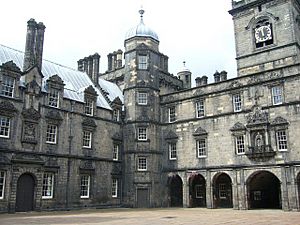Drinksilver facts for kids
Drinksilver was a special kind of payment, like a tip, given to skilled workers in Early Modern Scotland. This was a time long ago, roughly from the late 1400s to the early 1700s. The money was meant for the workers to buy drinks and celebrate their hard work.
Learning about drinksilver payments helps us understand how people worked, served, and supported each other back then. It shows us that even centuries ago, people appreciated good work with a little extra something.

Contents
What Was Drinksilver?
In old building records written in Latin, drinksilver was called bibalia. This word also means "for drinks." For example, when a bridge was being built over the River Tay, bibalia was given to two blacksmiths, Alastair and Andrew Smith, and their helpers.
Royal Payments for Workers
The money records of the Scottish kings and queens, kept by the Treasurer of Scotland, show many mentions of "drinksilver" gifts. This money was often given to construction workers, soldiers who handled cannons, tailors, and other craftspeople.
These gifts were usually given during royal visits or when a big part of a project was finished.
- In 1461, Mary of Guelders, a queen, gave 20 shillings to masons (stone workers) at the College of St Salvator in St Andrews.
- King James IV gave drinksilver to masons at Linlithgow Palace in 1491. This was when they finished three stone arches, which was a huge step in building.
- In 1497, he gave the masons at Linlithgow another tip of 9 shillings.
Drinksilver for Special Occasions
Drinksilver was also given for special events or tasks.
- In September 1561, "tailor boys" (young tailors) received drinksilver. They had worked hard making black mourning clothes for Mary, Queen of Scots, and her ladies. These clothes were for her grand arrival in Edinburgh.
- In November 1569, Regent Moray gave 20 shillings in drinksilver to soldiers. They had successfully taken goods from Lord Fleming at Boghall Castle.
Gifts for Junior Workers
Often, drinksilver was given to younger or less experienced workers.
- In May 1578, King James VI sent drinksilver to the tailors working for James Inglis.
- Young apprentices, sometimes called "childer," also received these payments. In 1598, the "childer" of a carpenter got drinksilver for setting up a nursery for Anne of Denmark at Dalkeith Palace.
- During the baptism of Prince Henry in 1594, the Edinburgh guild gave drinksilver to a "young man." He was a servant in the king's wardrobe and had provided cushions for important visitors.
Royal and Noble Households
Kings and queens weren't the only ones giving drinksilver.
- The records of King James V show many tips to servants. However, only gifts to his tailor's and shoemaker's servants were called "drinksilver." This was in 1540 when they delivered goods to him at Stirling Castle.
- When James VI visited Halidon Hill in 1588, he gave 100 gold crowns to English officers. He also gave 40 crowns, called drinksilver, to the porters (lower-ranking officers).
- In 1590, while in Denmark, James VI gave 12 gold coins as drinksilver. This was to a man who brought him horses as a gift from the Duke of Brunswick-Lüneburg.
Wealthy families also recorded drinksilver gifts in their household books.
- In July 1575, Agnes Keith gave 3 shillings to the "boys" (junior workers) of a bow maker and blacksmith in Edinburgh. They were making weapons for her husband.
- In 1619, Jean Drummond gave a gunmaker in Dundee £3 Scots in drinksilver. He was making pistols for her husband, the Earl of Roxburghe.
Building Projects and Legal Work
Large building projects often involved drinksilver.
- Masons working on George Heriot's School in the 1620s received drinksilver. This happened when they laid the foundations, started the first staircase, and finished the decorative "ledgement" around the building. They also got drinksilver on special quarter days throughout the year.
Even legal workers received drinksilver.
- Lawyers' clerks got drinksilver after meetings or when they finished writing important documents.
- Junior clerks at the Scottish exchequer (a financial office) also received it.
- In 1597, clerks who issued royal charters (official documents) were told not to ask for drinksilver. However, they could accept it if clients offered it.
- In 1640, the amount of drinksilver for the "man" or under-clerk in Glasgow was set. This was for people who wanted copies of property records.
- In 1646, people cleaning Stirling after the plague charged fixed rates. They were told "no further to be taken, nor yet any drink silver." This shows how common drinksilver was.
Different Customs in Other Countries
In 1590, Scottish diplomats offered drinksilver to town officials in The Hague. These officials had brought them a gift of wine. But the officials refused the money, saying they would lose their jobs if they took it. John Skene, a Scottish observer, noted that gift-giving customs were different in other countries.
What About Bounty Payments?
Another type of payment in Scottish records was a "bounty" or "bounteth."
- Bounties were payments given or promised to new household servants when they were hired. This was extra money, on top of their yearly wages.
- Sometimes, unpaid bounties were listed as debts in people's wills.
- These bounties might have been like money for shoes or linen for aprons. They were part of the agreement between the employer and the servant.
- These payments were similar to "livery" payments, which were special clothes or money given to royal servants.
Master masons also received bounty payments. For example, John Burnhill, who worked on Holyrood Palace and Falkland, received a bounty. In December 1540, he was given money "for his bounteth, and to buy him clothes, because he got never none of before." This means he had never received such a payment before.

